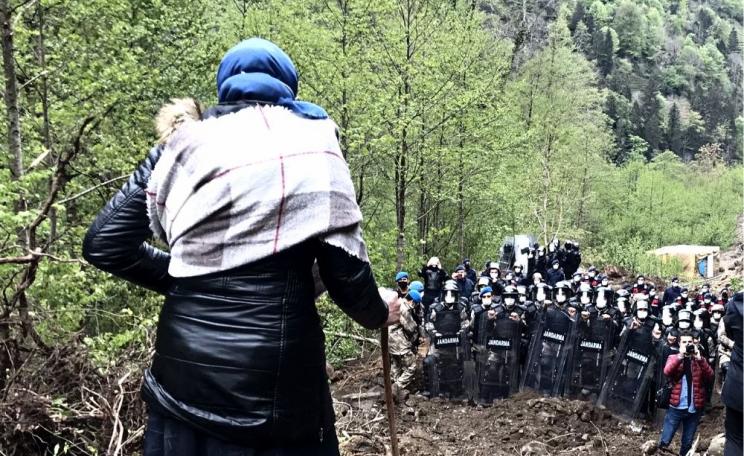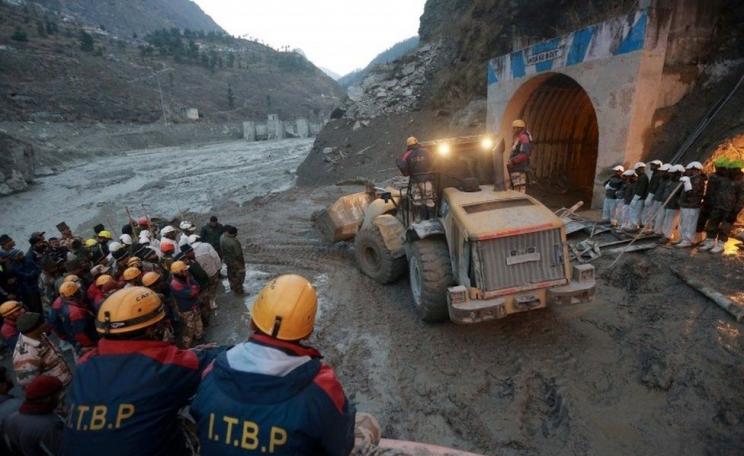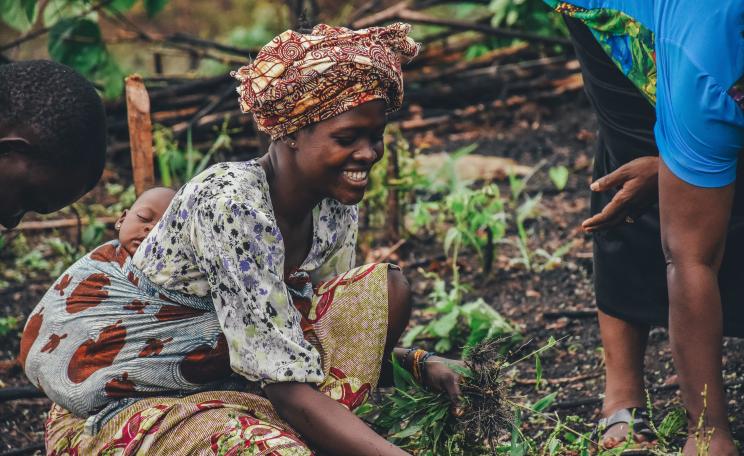Macaques are the ‘throwaway’ monkey.
The macaque panics frantically, trying to escape the net, then cowers down, trapped and frozen in fear. She’s pinned to the ground by a trapper’s foot with her front limbs forcibly pulled behind her back.
This article has been published through the Ecologist Writers' Fund. We ask readers for donations to pay some authors £200 for their work. Please make a donation now. You can learn more about the fund, and make an application, on our website.
Another, a baby, clinging on desperately, is dragged by her tail by her mother. Thrust into sacks or bundled into crates, the macaques huddle together for the pretence of safety. An unwanted male macaque is then beaten, throat slit, and discarded as waste.
Imported
These distressing scenes of trappers in Indonesia inflicting extreme cruelty on wild long-tailed macaques during their capture, as they begin their journey from the Indonesian jungle to life in a cage in a research facility, have been captured in footage released by Action for Primates.
In 2021, the Indonesian government reinstated the capture and export of macaques for sale to research labs, which has resulted in a recent rise in primates being ‘harvested’ from the wild for use in laboratories, according to researchers.
This has led the International Primatological Society to call on the industry to end their use of wild-caught monkeys, including their blood and body parts, calling the billion-dollar trade a “major threat to primate conservation.”
Between 2008 and 2019, 450,000 live long-tailed macaques were exported from Asia and Mauritius for use in research and testing, with over 50,000 wild-caught.
Data shows that more than 700,000 “specimens” including blood, tissue, and body parts from an unknown number of macaques were also exported from Asia. There are fears the actual number is significantly higher.
The USA, the world’s largest importer of primates for research, has imported an increasing number of wild macaques - the most recent data shows an increase from 174 in 2019 to 2,285 in 2020 from Cambodia and Mauritius.
Macaques are the ‘throwaway’ monkey.
Endangered
The USA is the only country to have imported wild macaques since 2014. An embargo on the export of long-tailed macaques from China during the coronavirus pandemic led to an increase in exports of both wild and farmed long-tailed macaques from countries such as Cambodia and Mauritius, and a resumption in trade from Indonesia, Lao PDR, and the Philippines.
In July this year, the International Union for Conservation of Nature announced that the conservation status of long-tailed macaques has been changed from 'vulnerable' to 'endangered’.
Other threats include the pet and entertainment trade, and killing for human consumption.
Sarah Kite, the co-founder of Action for Primates, stated: "This is a wake-up call for how we interact with the long-tailed macaque.
"Because of the impact of human activities on the species and its habitat, especially the global trade in research and toxicity testing, the future of this intelligent non-human primate is seriously under threat.
"Given that human beings are the cause of this threat, we have a moral obligation to act now to protect and conserve the long-tailed macaque.''
Suffering
The EU has introduced a ban on the import of wild-caught monkeys and offspring for research purposes, from November 2022, citing animal welfare, health, and ethical problems that arise from their capture.
Conflicts between monkeys and local communities are often given as the reason why authorities allow wild macaques to be captured or killed.
Sarah Kite explains: “An ever-increasing encroachment into wildlife habitat is tragically leading to avoidable conflicts and there are humane methods that can be used to prevent these.
"Despite widespread global concerns about the inhumanity of trapping wild monkeys and a new assessment of their conservation status, macaques continue to be torn from their natural habitat, family, and social groups. It’s a cruel trade that inflicts immense suffering.”
The IPS also asks editors of scientific journals to refuse to publish biomedical research that is conducted on primates sourced from wild populations.
Cages
The long-tailed macaque, a native of Southeast Asia, is the most heavily traded primate for use in laboratories. Historically, the trade relied on the capture of wild macaques.
However, the 1990s saw an increase in industrialised scale monkey farms in Cambodia, China, Laos, Mauritius, Vietnam, and now Indonesia.
Tens of thousands of macaques are held in barren, concrete, wire mesh pens devoid of foliage, a cruel contrast to their lush forest homes.
Dr Lisa Jones-Engel, a primatologist and Fulbright Scholar, said: “Macaques are incredibly social and clever, there’s almost nothing worse you can do than confine them in a cage.”
Indeed, the increase in the capture of wild primates mirrors the rise in the export of farmed macaques. The number exported by Cambodia to the USA almost tripled in two years, from 6,562 in 2018 to 19,582 in 2020.
In 2018, Mauritius exported 2,649 macaques which rose to 7,234 in 2020. Laos announced a 2022 export quota of 6,000, up from 3000, and the 2021 Indonesia quota was set at 2070 wild macaques. Authorities have confirmed the 2022 quota is postponed pending population surveys.
Macaques exported for research are transported in small transit crates and endure journeys of up to 48 hours as cargo on planes. In 2021, several monkeys died on a Wamos Air flight from Cambodia to the USA.
Abundance
There are grave concerns about the ecological impact this trade will have on the species as well as the environment.
Dr Malene Friis Hansen, director of the Long-Tailed Macaque Project and co-author of the IPS policy says long-tailed macaques are adaptable generalists, remove them from their habitats and you risk a cascade of ecological consequences.
“They are seed dispersers and forest and savannah regenerators, prey and predators - remove them and many ecological roles will be left unfilled," she said.
Macaques are also parasite reservoirs: “Remove the macaque, and mosquitoes will have to find another reservoir. There have been outbreaks of malaria in humans where long-tailed macaques have been removed.”
In 2006, it was estimated there were three million macaques in Southeast Asia, however, it’s believed that populations have been overestimated. Macaques have a preference for the forest edge, and so visibility has resulted in assumptions of over-abundance.
“We have a difficult time understanding that an animal can be endangered when we can find it and see it,” said Dr Hansen.
“In fact, if you enter the area behind them in the forest, for example, it may be devoid of macaques. If the trade continues, it can lead to the extirpation of unprotected populations.”
Illegal
Researchers also voice serious concerns that macaque farms may launder wild-caught as captive bred and regularly remove primates from their natural habitat to maintain upkeep.
Laos has previously been stopped from trading in macaques by CITES following concerns about the illegality of its macaque trade.
Little is known about the financial value of the trade, however, research shows that from 2010-2019, the international trade in macaques was worth $1.25 billion.
Macaques are sold for up to $10,000 in the USA commercial market. The high price that dealers pay for wild-caught macaques in Cambodia - which are then laundered to farms or smuggled abroad - has potentially led to their being wiped out from much of the country.
Dr Jones-Engel, a senior science advisor to animal rights group Peta, said: “Experimenters’ thirst for more and more monkeys is fuelling this lucrative trade. The animal experimentation industry has placed a target on these species and when enormous sums of money are involved monkeys die - and perhaps disappear entirely.
"The decimation of these species by the primate experimentation industry is going to have profound consequences.”
Indeed, whilst Cambodia has recently doubled its exports of macaques, campaigners say that it is very unlikely that Cambodia’s farms would have been able to double the production of macaques within one year- they breed slowly in captivity.
Toxicity
Over the last ten years, more than 250,000 macaques were imported to America’s research facilities and there are currently 108,526 monkeys in American laboratories. The USA has seven primate research centres.
Long-tailed macaques are the primary primate species used in toxicity tests carried out to assess the side effects of drugs or chemicals.
This involves restraining the monkeys who are injected or dosed via a tube that is forced into their stomachs using a process called “gavaging”. This is done without an anaesthetic.
The dosing can be daily for months or years with side effects including vomiting, fitting, internal bleeding, and death. “Macaques are the ‘throwaway’ monkey,” says Dr Jones-Engel.
China, Canada, Germany, France, and Japan, all use huge numbers of primates in research. In 2021, 2,679 experiments were performed on macaques in the UK.
Proponents of primate use for research say without animal research, we would be unable to produce life-changing medicines.
Survival
Yet a comprehensive 2015 study looked at whether toxicology tests in monkeys could help predict human responses, analysing data for over 3,000 drugs.
It concluded that the tests provide almost no evidence of the probability of there being a lack of side effects in humans when there are no side effects in animals.
Dr Jarrod Bailey said: “Animal drug tests are not fit for their stated purpose of predicting safety in humans.”
Dr Jones-Engel is similarly unequivocal: “More than a million macaques have been ripped from the forests, boxed up, shipped around the world, tortured and killed in labs.
“Scientists justify inducing extreme harm to primates with the promise of discovering new treatments for humans.
“However, species differences and the stress impact of laboratory life on these animals’ physiology, means data emerging from these experiments are too often not scientifically valid.”
She added: “Continuing to use monkeys violates the fundamentals of scientific integrity, and threatens public health and primate species' survival. It must stop.”
The Ecologist contacted all national primate research centres in the US to ask if they would, further to the IPS guidance, stop importing wild-caught macaques. The only response came from the Washington National Primate Research Center who said they were unable to comment by the time of publication.
This Author
Claire Colley is a UK-based freelance journalist and documentary film producer. This article has been published through the Ecologist Writers' Fund. We ask readers for donations to pay some authors £200 for their work. Please make a donation now. You can learn more about the fund, and make an application, on our website.




